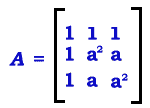Sections:
Power |
Impedance |
Students Challenge
Unsymmetrical Series Impedance
 Definition.
Definition.
Assuming that there is no coupling, i.e., no mutual inductance between the impedances, thus the voltage drop would be:

Multiplying both sides by the unit matrix of a, we have:
 , where:
, where: 
 To eliminate the A matrix on the right side,
To eliminate the A matrix on the right side,
we should multiply it with A-1, where this is equal to:

Thus, the voltage equations will be:
Vaa'1 =
(Ia1/3)
(Za+Zb+Zc) +
(Ia2/3)
(Za+a²Zb+aZc) +
(Ia0/3)
(Za+aZb+a²Zc)
Vaa'2 =
(Ia1/3)
(Za+aZb+a²Zc) +
(Ia2/3)
(Za+Zb+Zc) +
(Ia0/3)
(Za+a²Zb+aZc)
Vaa'0 =
(Ia1/3)
(Za+a²Zb+aZc) +
(Ia2/3)
(Za+aZb+a²Zc) +
(Ia0/3)
(Za+Zb+Zc)
Important Notes.
1. If Za =
Zb =
Zc then:
Vaa'1 =
Ia1Za
 Vaa'2 =
Ia2Za
Vaa'2 =
Ia2Za
 Vaa'0 =
Ia0Za
Vaa'0 =
Ia0Za
2. If mutual inductance exist, then the impedance square matrices of the above equations [voltage drop equation and the equation multiplied by the A-matrix] would contain off-diagonal elements and the last set, the voltage equations, would contain additional terms.
Sections:
Power |
Impedance |
Students Challenge
Students Challenge
Assignment
Solve the following problems:
No. 11.6/p.303
No. 11.7/p.303
No. 11.8/p.303

